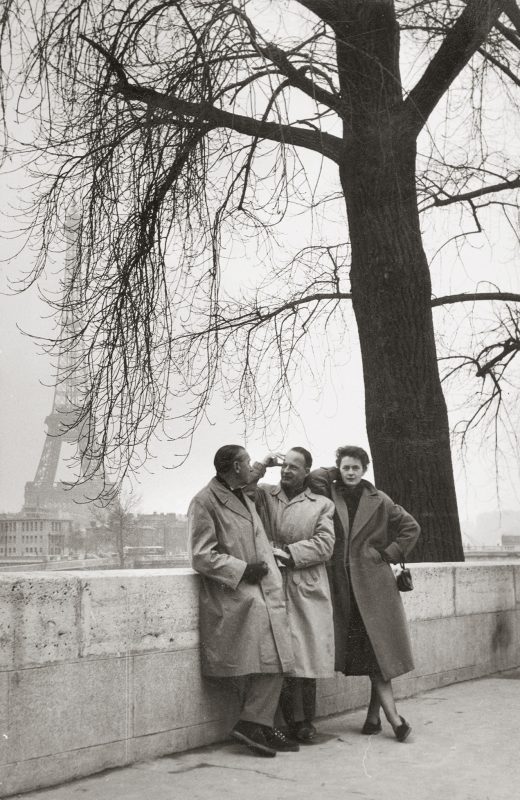1958–1969

in Paris, 1953
Peiffer Watenphul moved to Rome in the autumn of 1958, where he lived in the studio on the Via dei Greci, near the Piazza di Spagna. It was a very small but elegant apartment, with two rooms on the top floor. A tiny spiral staircase led into the little studio, which opened onto a terrace with a view of Pincian Hill. No street noise could be heard, only the music of the nearby Accademia di Santa Cecilia. Here, he painted on a table without an easel, a practice that he had already adopted in Venice. One could find him painting that way in the early morning, and by nine o’clock, he had usually already finished a painting. There were agaves on the terrace in the lovely gray-blue tones later to be found in his paintings. The walls were hung with works by painter friends, a collection that he had assembled through exchanges with other artists over the years. His great joy was his collection of small Greek sculptures. The little kitchen had a pink tile floor, and there, Max Peiffer Watenphul, a passionate cook throughout his life, renowned for his recipes, cooked his meals. During his Roman period, Peiffer Watenphul took many trips to the south of Italy. Since he did not drive, he went with friends or took the train. He often took excursions into the familiar Roman countryside, where he drew or painted watercolors. He took multiple trips with the journalist Josef Schmitz van Vorst to Campania, Calabria, Apulia, Umbria, and Monte Gargano. He spent most winters in Rome. He counted the journalists Gustav René Hocke and Erich Kusch among his friends. Peiffer Watenphul always went on early Sunday mornings to the Roman flea market at the Porta Portese to buy frames, sculptures, and jugs. He then reworked the frames himself. The artist would usually spend the spring on Ischia or in the south of Italy. Although his favorite opera was Bizet’s Carmen, Peiffer Watenphul worshipped Mozart, and in the summer was in Salzburg for the Salzburg Festival. Most Septembers he spent in Germany. The artist spent a month in Lebanon in 1960. Peiffer Watenphul traveled to Greece with his English friend Moore Crosthwaite in October of 1961. It was the first journey to bring him into contact with the Hellenistic world, and it took him to Athens, Delphi, Corinth, Nafplion, Olympia, and Sparta. The trip back was to Rome via Corfu. Afterward, he went to Greece with regularity. Beginning in the spring of 1964, Peiffer Watenphul went yearly to Corfu, where he rented a small apartment. He usually spent a few months on the island. At the time, it was hardly visited by tourists, although a small English colony existed. These were uplifting stays for the artist. On Corfu, he lived as he loved to live, simple in form, but demanding in his human contacts. Even in his later years, Peiffer Watenphul sought to learn modern Greek, and took lessons in the language from the Greek monks who lived on the Via dei Greci.

The artist’s mother died in Rome in February of 1963. The next year, Peiffer Watenphul was brought to the International Summer Academy for Fine Arts in Salzburg as Kokoschka’s successor. His tenure at the Summer Academy was another happy segment of his life. Teaching at the fortress was not an everyday experience. It was a place that brought together pupils from many countries, speaking many languages, and with the most various perspectives on life. He taught there for three summers, and was a very popular teacher. Peiffer Watenphul gave each pupil the freedom to develop his own style and his own personality. He made corrections, but forced no one to accept his views. In 1964, the city of Salzburg awarded him its Ring of Honor. After the Summer Academy of 1964, the artist traveled through northern Europe with his niece Alessandra; they went through Germany to Denmark and Sweden and returned to Rome via Paris and the south of France. The artist was named a full member of the Bavarian Academy of Fine Arts in Munich on May 20, 1965.
In the nineteen-sixties, the Frankfurt publisher Gotthard de Beauclair and Peiffer Watenphul realized their long-held artistic plans. The first project to come about, in 1966, was the publication of the Buch Suleika and the Schenkenbuch from Johann Wolfgang von Goethe’s West-östlicher Divan. Other lithographic portfolios followed, including Kavafis Mappe (1967), Griechenlandmappe (1968), and Venedig I and II (1969).
In 1966, at the request of his sister, the artist began to paint frescoes in the chapel of the country estate Il Pero, near Siena. The frescoes were not finished until July of 1967. In that year, Peiffer Watenphul illustrated a German translation of Truman Capote’s “A Christmas Memory,” for the publisher Max Niedermayer in Wiesbaden. He went to Tunis in April of 1969.
Max Peiffer Watenphul was awarded the Grand Federal Cross of Merit of the Federal Republic of Germany in November of that year.
